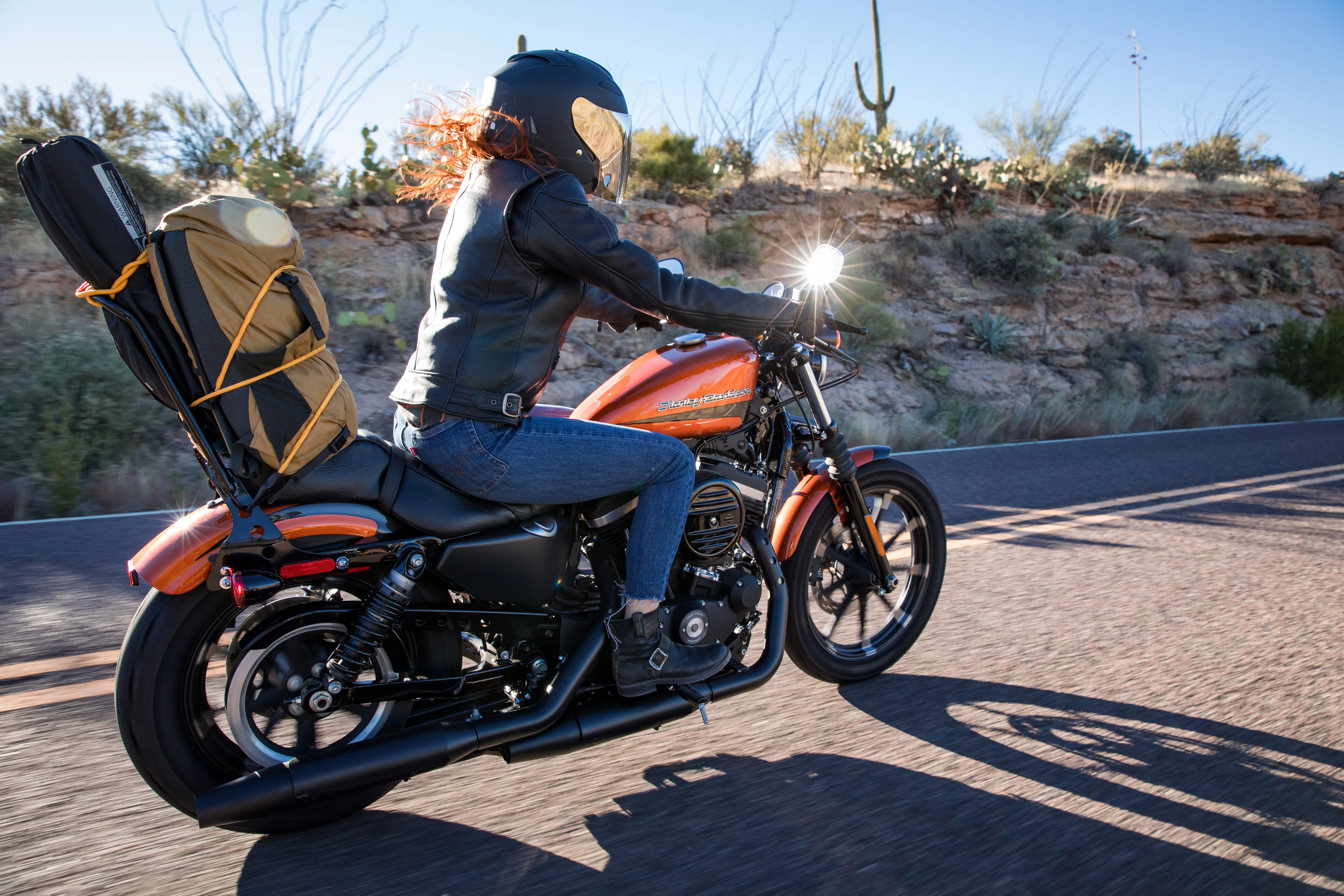Table of Contents
22 Tips for your next motorcycle trip
One of the first questions to ask yourself before planning a trip definitely is: how many days can we afford to leave? Then, you’ll think about the budget. Be careful about preconceptions to choose your destination. For example, a preconception is to think that travelling to Europe is expensive, but the truth may be that sometimes, visiting Canada can be cheaper…
Depending on the destination you’ll choose, you can ask yourself the following questions… Do you want to drive your motorcycle there? Do you want to have your motorcycle delivered there? Is it better to rent a motorcycle there?

If you’re looking for a motorcycle carrier, I suggest Amérik@Moto, a team of professionals that will take care of you and your motorcycle. Everyone I know who did business with this company are happy about it.
To rent a motorcycle, if you’re a fan of Harley-Davidson, there are more than 350 Harley-Davidson® Authorized Rentals agencies in the world. Click on FIND A RENTING AGENCY to find a Harley agency next to you or your destination, and book your motorcycle online.
In some insurance contracts (small writing), you cannot stay more than 90 days per year. This has to be checked.
If you’re planning to take your motorcycle on a long trip, make sure your motorcycle is in working order. A mechanical inspection at your concessionaire is often the best option.
If you’re leaving to drive 3 000 kilometers, tell your concessionaire. He’ll be able to guide you through tire wear, and also tell him if you plan on travelling with a passenger.

Here’s a list of points to check before your trip and some useful info to complete your trip:
1Change oil and tune-up before leaving and make sure tires are in good condition for the entire trip. All tires must be inflated to the minimum and maximum pressure listed on the sidewall or in the owner’s manual.
Check the tread. All tires have a wear bar that appears on the surface of the tread. If the wear bar is almost flush with the tire tread, or if there are unusual patterns such as flat spots or notches, it’s time to buy new tires;
2
During your trip, depending on your destination, if you visit a city that has hot weather, check your oil levels more often;
3
It is recommended to measure the motorcycle oil while it is cold, this method is considered to be more efficient I’m just repeating what experts say 😉
4Check the condition of the brakes, without taking the brake caliper to pieces, you can check with one glance the brake pad wear;
5
Adjust the suspension of your motorcycle depending on our luggage or if you have a passenger to avoid any long term damage;
6Make sure all the safety lights work well to be well seen (blinkers, brake lights, full headlights and main-beam headlamps);
7
Make sure the gas cables and others are in good condition and have no deficiencies when it comes to the sheath;
8
Make sure the honk works properly. In many countries, the horn is used to warn other drivers of your presence;
9
Look carefully at your motorcycle stand for cracks or creases. Check the retaining spring and make sure it is in good condition and holds the stand firmly in position;
10
Spare key to be placed in a plastic zippered envelope in a safe place on the motorcycle or with the accessories;
11
Tire Repair Kit/Air Pump – a pair of universal pliers will come in handy in many cases to avoid being stranded on the side of the road;
12
Fuses, spare bulbs, spark plugs and a pressure gauge to check tire inflation may also be useful, as well as a rag or two;
13
Before riding, make sure the accessories are securely stowed to keep the center of gravity as close to the ground as possible and as close to the center of the motorcycle as possible. Distribute the weight approximately equally in the saddlebags on each side of the motorcycle. The rear rack should be used primarily to store lighter items. Make sure all luggage is securely fastened with bungee cords or mesh;
14
Layer clothes to minimize the amount of clothing you’ll carry. Bring clothes that are multifunction and can work in many different weather conditions;
15
Important documents kit. The kit should contain a photocopy of all the credit cards you bring with you: driver’s license, motorcycle registration, travel and vehicle insurance policies and roadside assistance card. Store them in a waterproof pouch that also contains a list of names and phone numbers in case of an emergency;
16
First aid kit: it should include large sterile dressings, a sanitizer, an elastic bandage in case of spraining and painkillers;
17
If you bring your phone to the US, make sure to have a US plan. Know that the roaming charges are high and that it is better to turn off your phone;
18
A metal or plastic plate to insert under the side stand when stopping on gravel, sand, grass and even very hot asphalt;
19
Road maps with the places you don’t want to miss or a GPS, the road map is handy when there is no longer cellular network available;
20
What types of food (solid or liquid) can you bring into the United States as a traveller? https://usaestaonline.com/fr/aliments-que-vous-pouvez-apporter-aux-etats-unis
21
It is easy to forget about it, but staying hydrated will help you keep a nice energy throughout your journey. Having a water bottle in your luggage or even a hydration pack can be good options;
22
1. Be ready to face Mother Nature, a raincoat is an amazing investment. Like they say in the motorcycle world:
There is no bad weather, only bad equipment
Other questions to ask yourself
If your trip requires a minimum of preparation, many questions can be used as a framework to define your itinerary, given the fact that you already have a destination in mind and that you drive your motorcycle there.
▪ How long will it take me to reach the final destination?
▪ How many kilometers can I drive per day?
▪ How much time do I have between two stopovers? (Latest check in time of the hotel or camping)
▪ Does the initial itinerary present any specific difficulties (Congested and technical road, unpredictable weather)?
▪ Where to take a break on the road?
▪ Where to stock up in gas and/or food?
▪ Are there any points of interest on the road?
▪ Does the road require a specific mode of transportation or an obligatory toll?


ANOTHER IMPORTANT POINT: WHAT ARE THE TRAFFIC REGULATIONS AND RULES IN THE VISITED COUNTRY? Make sure to be informed before hitting the road.
Don’t forget:
• A valid passport is you travel to the United States or elsewhere.
• American $$ if you travel to the United States.
• Debit and credit cards.
• Towing insurance (CAA or other). Make sure to have an insurance of at least 2 million for your trip to the United States.
• Confirmation numbers of hotel reservations.
• Sunscreen.
• Lipbalm with SPF.
• Sunglasses.
• Prescription drugs.
• Tylenol, antihistamine and a first aid kit.
• Personal hygiene products (toothbrush, shampoo, etc.).
• Earplugs (the wind can cause fatigues and damage hearing)
Are you a technology fan? Here are some interesting mobile apps
https://www.facebook.com/groups/panamtravelers/
https://itunes.apple.com/fr/app/raintoday/
https://itunes.apple.com/fr/app/essence-gasoil-now
https://roadtrippers.com/canada/
https://www.facebook.com/WeRideApp/
https://maps.harley-davidson.com/ RIDE PLANER–GPX HARLEY
One last tip: if you’re like me and you love adventure, leaving without a destination this year might be something to avoid. The post-pandemic travel enthusiasm is real and some hotels in Québec are already fully booked for the summer. So, plan your trips to make sure not to have to find a place to sleep after a long day of driving your motorcycle.
My last words would be this: if you think adventure is dangerous, try having a routine. It is fatal.



